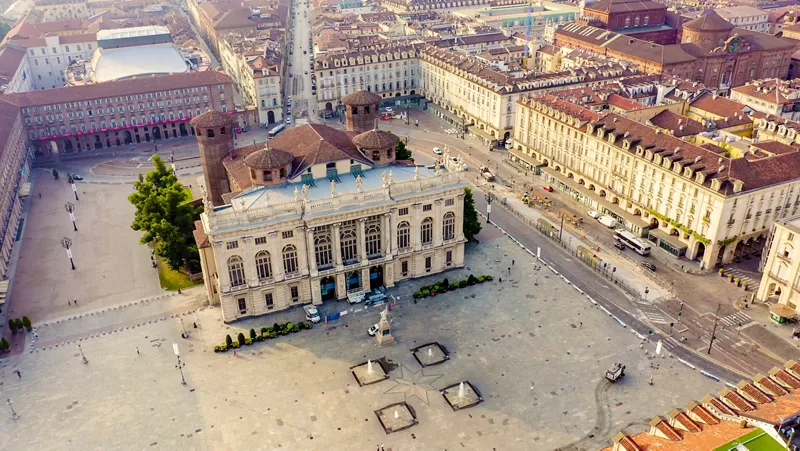Turin and the magnificent Savoy residences
4 minutes
The heart of the Kingdom of Savoy for centuries, Turin was the stage and driving force behind national unification, as well as the first capital of the Kingdom of Italy.
Visiting Turin offers the perfect opportunity to discover the splendid royal residences that the Savoy family had built between the 17th and 18th centuries: a journey through time among the symbols of the dynasty's hegemony, from hunting castles to holiday resorts and the imposing residences declared a UNESCO World Heritage Site.
Ready for an adventure in the beautiful Turin of the Savoy dynasty?
What are the Savoy residences and where they are located?

The Savoy residences were the headquarters of the powerful Savoy family, built from 1563 onwards between the city of Turin, capital of the Duchy of Savoy, and its province, where the Savoys liked to spend time hunting or relaxing not far from the centre of command.
The Savoys chose Turin as their so-called Command Zone in the centre of the city, from which they reorganised their territory. It is here that you can admire and visit the Savoy residences.
A complex of buildings, 11 of them recognised by UNESCO, where they exercised power through politics, government and culture: the Royal Palace, the Royal Armoury, the Palace of the Prefecture and State Archives, the façade of the Royal Theatre, the Military Academy, the Royal Cavalry, the Royal Mint, Chiablese Palace, Madama Palace and Carignano Palace.
Around the city, radiating out from its centre, are the other 11 suburban residences used by the Savoy family for leisure, parties and hunting. There is the Corona di Delizie (Crown of Delights), consisting of Valentino Castle, Villa della Regina, Moncalieri Castle, Rivoli Castle, Venaria Reale Castle, the Palazzina di Caccia of Stupinigi, Agliè Castle, the Castle of La Mandria, the Castle of Racconigi, the Royal Castle of Pollenzo and Agenzia di Pollenzo, and Govone Castle.
The history and magic of the Savoy residences

The Savoy dynasty arrived in Turin when it was still a medieval city and immediately made it the capital of the Duchy of Savoy, setting in motion a vast building programme that brought a new lease of life to Turin, transforming it into a metropolis with strong connections to the royal courts throughout Europe.
For more than a century, starting in 1563, the Savoys commissioned the renovation of ancient castles and the construction of new residences to consolidate and celebrate their absolute power and show the world the wealth and influence of Turin.
Why the Savoy residences became a UNESCO site

In 1997, UNESCO added some of the landmarks of the Savoy dynasty to its World Heritage List, selecting 22 of the administrative and recreational palaces and villas built by the Savoy dukes, 11 in Turin and 11 from around the city.
The Savoy residences have become part of this extensive UNESCO site because they provide exceptional evidence of the exuberant genius of Baroque and late Baroque art and architecture, created over many decades by illustrious architects, including Ascanio Vitozzi, Benedetto Alfieri, Amedeo di Castellamonte and Filippo Juvarra.
What to see at the Savoy residences

If you are ready to be enchanted by the splendid palaces and magnificent villas of the Savoy family, you are sure to be spoilt for choice among such beauty: here are our top picks.
Turin's unmissable sites
The Royal Palace, in the historic centre of Turin, symbolises the power of the Savoy family. With its 17th-century façade and richly decorated interiors, you can enjoy a taste of the luxury and elegance of the time, with tours of the apartments that once belonged to the Prince of Piedmont and the Duke of Aosta.
Next to Piazzetta Reale stands Madama Palace, with its elegant façade designed in the early 1700s by architect Filippo Juvarra for Madame Royale Marie Jeanne Baptiste of Savoy-Nemours.
Carignano Palace, overlooking Piazza Carlo Alberto, was the residence of the Princes of Carignano from 1694. Built in two different periods, part of the Palace dates back to the 17th century while the rest was built in the 19th century, with different styles clearly visible even to the untrained eye. Today, it houses the National Museum of the Italian Risorgimento.
Valentino Castle, along the banks of the Po, boasts a distinctly French style related to the numerous alterations it has undergone since the late 17th century. Today, it houses the Department of Architecture and Design of the Polytechnic University of Turin.
While you’re in the town, check out the Villa della Regina (Villa of the Queen), with its 17th and 18th century paintings, original period furnishings and huge Italian garden featuring a large fountain with a marble sculpture of the god Neptune.
Around the city
On the outskirts of Turin, it is worth visiting Rivoli Castle, originally a military stronghold and now home to the Museum of Contemporary Art, and the Royal Palace of Venaria, used by the Savoy family as a former hunting lodge, dubbed by many as the “Italian Versailles”. Inside, you can explore the Hall of Diana, the Great Gallery, the Church of Saint Hubert and some of the most beautiful gardens in Italy.
Also worth a visit is Agliè Castle, with its three hundred lavishly decorated rooms, which are open every day together with the surrounding gardens that only came into the possession of the Savoys in 1823.
Last but not least, we have the Royal Castle of Racconigi, with its thousand-year history that began well before the Savoy family made it one of their holiday residences. As well as admiring its imposing façades, you can tour inside from Thursday to Sunday through the first floor, the second floor and the 19th-century kitchens.





























